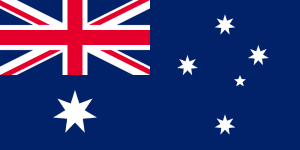
| Colors | HEX Code | RGB | CMYK |
|---|---|---|---|
| Red | #E4002B | 228, 0, 43 | 0, 100, 81, 11 |
| White | #FFFFFF | 255, 255, 255 | 0, 0, 0, 0 |
| Blue | #012169 | 1, 33, 105 | 99, 69, 0, 59 |
The Australian flag is a design that gathers different types of crosses with different types of stars. The background of the flag is blue. The crosses which represent the Union Jack, St. Andrew and St. Patrick crosses are located on top of the flag near to the mast . A big, seven-edged star called the commonwealth star falls under the three crosses. Then , there are the five stars of the southern cross that decorate the other part of the flag. 4 stars are of the same size, with one star that is smaller.
Meaning of the Australian Flag
The three crosses on the Australian flag represent the principles on which the Australian nation is founded, which are parliamentary democracy, the rule of law, freedom of speech and the rights and responsibilities of citizens. The seven-edged commonwealth star represents the six states, with the seventh edge to represent all other Australian territories. The five stars of the southern cross represent Australia’s geographical location in the Northern Hemisphere, and the cultural diversity of the country with its aboriginal roots and indigenous legends.
History of the Australian flag
Australia became a federation on July 9, 1900. In 1901, a competition was held to choose the best design that represents the new federation. 5 entries with identical designs won the competition, and the flag became official on September 3, 1901. In 1903, King Edward VII suggested minor changes. The flag was used in an act of war during WWI. in 1996, Sir William Deane proclaimed September 3 as “Australian National Flag Day”, commemorating the first time the Australian flag was hoisted in 1901.